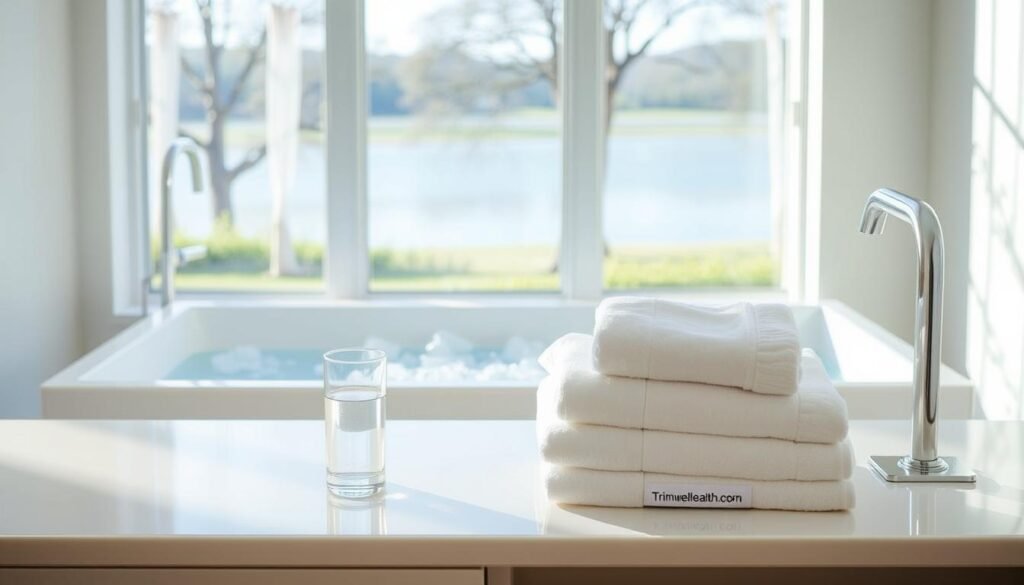Ice Baths for Beginners—What to Know Explained
Ever thought about putting your body in near-freezing water to get better at sports or heal faster? This guide is for those new to ice baths. It talks about cold therapy and its benefits, but also how to do it safely.
Ice baths are becoming more popular. They help with physical and mental recovery. Find out how they can change your recovery process.
Key Takeaways
- Ice baths are a popular tool for physical recovery among athletes.
- Cold therapy may provide significant benefits, including pain relief and immune support.
- Beginners should start with cautious steps to avoid possible risks.
- The right water temperature is key for a safe ice bath.
- Recovering well after an ice bath is as important as the bath itself.
- Knowing your body’s signs during cold exposure can make the experience better.
Understanding Ice Baths and Cold Therapy
Ice baths are getting more popular as a way to recover for athletes and fitness fans. They involve sitting in cold water. It’s good to know what ice baths are and how they work for those starting out.
What Are Ice Baths?
Ice baths are when you sit in water that’s really cold, between 39°F and 59°F. People have used them for a long time to help muscles heal and feel better. Many say they help with recovery and make them feel clearer in their mind.
How Cold Therapy Works
Cold therapy makes your body cool down to help it in special ways. When it gets cold, your blood vessels get smaller. This helps reduce swelling, pain, and speeds up muscle healing.
It also helps your blood flow better and balances your hormones. This makes you feel better overall.
| Aspect | Benefits |
|---|---|
| Inflammation Reduction | Decreases swelling and pain in troubled areas |
| Muscle Recovery | Accelerates recovery time post-exercise |
| Mental Clarity | Enhances focus and mood |
| Circulation Improvement | Boosts blood flow and nutrient delivery |
Ice Bath Benefits
Ice baths are popular among athletes and fitness fans. They help with physical recovery and make the body stronger. Knowing these benefits can help you choose the best wellness routine.
Physical Recovery and Pain Relief
Cold baths help muscles recover. They reduce soreness and tiredness after hard workouts. Cold water makes blood vessels smaller, which lowers swelling and pain.
So, athletes can get back to training faster. This helps them perform better and live longer in sports.
Boosting Immune Function
Cold therapy does more than just help muscles. It also boosts the immune system. People who use cold therapy often get sick less and have more energy.
The body’s response to cold makes it stronger against sickness. This makes the immune system work better.
How to Take an Ice Bath
Taking an ice bath can be exciting. But, you need to prepare well for it. You should know how to set up and what to do. Here are some tips to make your ice bath better.
Preparation Steps
Before you get into the ice bath, get your things ready. You’ll need a towel, warm clothes, and a hot drink. It’s also good to practice deep breathing to handle the cold.
This helps you feel less uncomfortable and stay focused.
Setting the Right Temperature
The water should be between 50°F and 60°F for your first time. This temperature is gentle for beginners. Always check the water’s temperature before you get in.
Having a safe place to bathe is key. It’s a good idea to have someone with you for support. These steps will make your first ice bath easier.
Ice Baths for Beginners—What to Know
Ice baths are great for recovery and mental strength. Start slow and stay safe as you get used to the cold. This guide will help you start right.
Starting Slow and Safe
Beginners should start with short times in the ice bath. Try 1-2 minutes first. Then, you can slowly add more time as you get more comfortable.
It’s important to listen to your body. If you feel numb or too uncomfortable, get out right away.
Duration Recommendations for Beginners
Experts say don’t stay in for more than 10 minutes at first. This helps avoid problems like frostbite or feeling dizzy. Slowly getting used to it makes it better and more fun.

Best Practices for Ice Baths
Using the best practices for ice baths can make your experience better. It’s key to listen to your body and breathe right. This way, you get the most benefits without feeling too much pain.
Breathing Techniques
Slow, controlled breathing helps when you first get into the ice. It makes your body get used to the cold. Try breathing in through your nose for four counts, hold for a bit, then breathe out through your mouth for six counts.
This helps calm your mind and keeps your body steady.
Monitoring Your Body’s Response
It’s important to pay attention to how your body feels in the ice bath. Look out for signs like shivering, tingling, or feeling dizzy. These signs mean it’s time to get out.
Listening to your body keeps you safe and makes sure you get the most out of the ice bath.
Post-Ice Bath Recovery Tips
Good recovery tips after an ice bath can help you heal faster. After getting out, put on warm clothes. Then, do some light stretching or walking to get your blood flowing again.
Ice Bath Recovery and Performance Enhancement
Ice baths help athletes recover fast after hard workouts. They fight muscle soreness and improve blood flow. This helps get rid of waste quickly. Knowing how to use ice baths is key for better muscle recovery.
Improving Muscle Recovery
Using ice baths after workouts helps muscles heal faster. Studies show cold water can cut down soreness. This lets athletes get back to training sooner.
Ice baths are best used after hard workouts. They help the body recover well. But, it’s important to use them right to avoid losing strength.
Reducing Inflammation and Soreness
Cold water helps reduce pain and makes the body stronger. It’s best to use this method right after hard exercise. This way, it works best.
Adding ice baths to your recovery routine can boost your performance. For more on how ice baths work, check out this research.
Common Mistakes to Avoid
Ice baths can be very helpful, but new users often make mistakes. Knowing these mistakes helps you get the most out of ice baths safely. Learning the right way to do ice baths makes it better and more fun.
Overdoing the Duration
Many people think longer ice baths are better. But, too long can cause pain, numbness, or even frostbite. Start with short times, like one to three minutes, and slowly get longer as you get used to it.
Ignoring Body Signals
It’s important to listen to your body in an ice bath. Some might ignore feeling cold, dizzy, or shivering too much. This can be very dangerous, like getting too cold. Always listen to your body and get out if you feel bad.
| Mistake | Impact | Tip |
|---|---|---|
| Spending Too Much Time | Increased discomfort, risk of frostbite | Limit initial sessions to 1-3 minutes |
| Ignoring Body Signals | Potential health risks, including hypothermia | Always listen to your body’s warnings |
Ice Bath Precautions
Before you jump into an ice bath, it’s key to think about safety and how well it works. You should check if you’re healthy enough for this cold therapy. Some health issues might need extra care or a doctor’s advice, as cold can affect people differently.
Health Conditions to Consider
People with health problems should be careful with ice baths. Here are some conditions to watch out for:
- Cardiovascular Issues
- High Blood Pressure
- Poor Circulation
- Respiratory Problems
- Recent Surgeries
If you have any of these, talk to a doctor before trying cold therapy. Knowing these risks helps you decide if ice baths are right for you.
Cold Shock Response Risks
The cold shock response can be dangerous, mainly when you’re suddenly in cold water. It might cause:
- Hyperventilation
- Increased Heart Rate
- Muscle Spasms
- Loss of Consciousness
Knowing these risks shows why ice bath safety is so important. It’s best to do ice baths with someone watching, or at least with a partner. Learning the right way to do it can make it safer and more effective.

Tips for a Successful Ice Bath Experience
Creating the right atmosphere is key for a great ice bath. Choose a comfy spot for your ice bath. This makes it easier to get what you need before and after.
Choosing the Right Environment
Think about a safe and cozy spot for your ice bath. A bathroom or basement is often best. Make sure you have towels and warm clothes ready.
Having a warm drink can help warm you up fast. The right place makes your ice bath better.
Using Towels and Warm Clothing
Staying warm after an ice bath is important. Use thick towels to dry off fast. Wear warm clothes to get your body warm again.
Being comfortable helps you enjoy the ice bath more. This makes it a better experience.
Conclusion
Ice baths can help you feel better overall. They are great for athletes and anyone wanting to improve their health. Using ice baths can change your life for the better.
It’s important to start slow and listen to your body when trying ice baths. This helps you stay safe and enjoy the benefits. As you get used to it, you’ll see how it improves your health and mood.
Adding ice baths to your routine can make you feel stronger and happier. Learning how to do it right and listening to your body is key. This way, ice baths can become a big part of your self-care, helping you in many ways.
FAQ
What is the ideal temperature for an ice bath for beginners?
Beginners should aim for a temperature between 50°F to 60°F. This helps avoid too much discomfort while getting cold therapy benefits.
How long should a beginner stay in an ice bath?
Start with 1-2 minutes for beginners. Gradually add more time as you get used to the cold. Don’t stay longer than 10 minutes.
What are the primary benefits of ice baths?
Ice baths help with physical recovery by reducing soreness and inflammation. They also boost your immune system and mental strength.
What should I prepare before taking an ice bath?
Get a towel, warm clothes, and a warm drink ready. Also, practice deep breathing to help you relax.
Are there any risks associated with ice baths?
Yes, there are risks like cold shock response and hyperventilation. People with heart problems should be careful. Always talk to a doctor first.
What is the cold shock response?
Cold shock happens when you quickly get into cold water. It can cause hyperventilation and a fast heart rate. Slowly get used to the cold and listen to your body.
What strategies can help with ice bath discomfort?
Use slow, controlled breathing to handle cold shock. Also, pay attention to your body and get out if you’re uncomfortable.
Can ice baths help improve athletic performance?
Yes, ice baths can help athletes by speeding up muscle recovery. They also reduce muscle soreness and help you recover faster between workouts.
How often should I take ice baths for recovery?
Use ice baths after hard workouts or competitions. But don’t do it every day. Listen to your body and adjust as needed.
What should I do immediately after an ice bath?
Put on warm clothes and do some light exercise to get your blood flowing. Then, have a warm drink to warm up your body.


